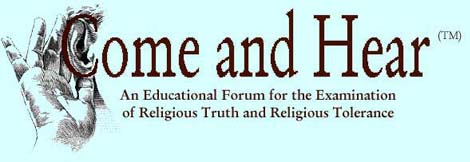New America
6. Talmud Daughters Become Talmud Wives

There are changes in the wind. Some people may be happy, some may be unhappy. Let's go directly to the Talmud to see its laws on some social concerns.
| Navigate This Site | |
 | |
| Home | |
| Valentine | |
| Dilling | |
| Talmud | |
| The Rabbis | |
| Supplement | |
| Glossary | |
| Download | |
| Admin | |
| | |
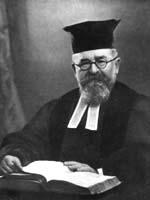
The late Dr. Joseph Herman Hertz, the Very Reverend the Chief Rabbi of the British Empire, 1913 - 1946.
"A conclusive proof of woman's dominating place in Jewish life is the undeniable fact, that the hallowing of the Jewish home was her work; and that the laws of chastity were observed in that home, both by men and women, with a scrupulousness that has hardly ever been equalled. The Sages duly recognized her wonderful spiritual influence, and nothing could surpass the delicacy with which respect for her is inculcated: 'Love thy wife as thyself, and honour her more than thyself. Be careful not to cause woman to weep, for God counts her tears. Israel was redeemed from Egypt on account of the virtue of its women. He who weds a good woman, it is as if he had fulfilled all the precepts of the Torah' (Talmud)." — Rabbi Dr. J.H. Hertz (21)
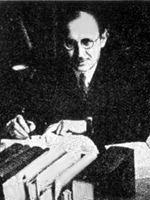
Rabbi Dr. Isidore Epstein writes in the "Introduction" to Seder Nashim:
"The Rabbis of the Talmud, unlike the Church Fathers, never attached any stigma to marriage." (22)
"The marriage laws as developed by the Rabbis in the Talmud only served to confirm and deepen the elevated view of married life." (23)
"This elevated view of marriage is likewise reflected in the Talmudic law of divorce … the Talmud with its elevated view of marriage considers the separation of husband and wife which divorce entails, a domestic tragedy for which 'the very altar of God sheds tears', and for this reason declares that 'he who dismisseth his wife is hated by God'. Yet with all their abhorrence of divorce, the Sages held the continuance of intimate relations between husband and wife after the bonds of affection were snapped to be immoral …" (24)
But "the bonds of affection" are permitted to snap for only one party — the husband. His right to suffer loss of affection is enshrined in Talmud law. The wife's right does not exist.

"Samuel G. Freedman is an award-winning writer and professor. A former reporter for The New York Times, he is the author of the four acclaimed books, most recently Jew vs. Jew: The Struggle for the Soul of American Jewry" (20)
"In the struggle for the soul of American Jewry, the Orthodox model has triumphed." — Samuel G. Freedman (13)
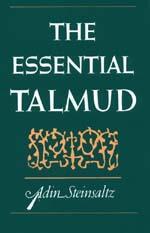
"Neither a father nor any other individual may impose his will on an adult daughter or attempt to force her into a marriage against her will." — Rabbi Steinsaltz (15)
But what about minor daughters? Given the early age of marriageability, a father's prerogative to marry off his minor daughters, social pressures to marry young, and cultural approval of polygamy, few Talmud woman would reach adulthood while yet unmarried.
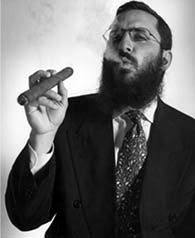
Rabbi Shmuley Boteach, Orthodox rabbi and popularizer of Judaism, writes in Judaism for Everyone:
"The Torah also made marrying a woman against her will illegal and imposed extremely harsh penalties on rape."
Rabbi Boteach also explains that, "Torah refers to all 24 books of the written law plus the oral code as written and compiled by the ancient rabbis in the Mishnah and the Talmud." (28)
To see some of the Talmud doctrines on marriage and rape, read Kethuboth 39a, Kethuboth 46b, and Kethuboth 48a-48b. You will notice that Rabbi Boteach's statement does not quite fit the facts.
The Evening Standard describes Rabbi Boteach as follows:
"He talks brilliantly, nine times faster than is quite normal … he puffs on a giant cigar as secretaries run in and out with messages from newspapers around the world." — The Evening Standard (26)

"US President George W. Bush sent greetings and applauded the institute for promoting an 'understanding of Judaism's rich tradition of legal thought. As we face new challenges and welcome new opportunities, our society must continue to promote good character and strong values. Through the study and teaching of Jewish law and philosophy you are contributing to a growing culture of service, citizenship, and responsibility in America,' Bush wrote." (6)
The occasion was a kosher dinner held at the US Supreme Court Building in Washington, DC by the National Institute of Judaic Law to celebrate the occasion of the Institute's founding. According to the Jerusalem Post, the purpose of the Institute is to teach Judaic law to US law students and jurists, and to file legal opinions in US courts. (6)

Betty Friedan received the American Jewish Committee Award for Distinguished Jewish American and Israeli Feminists in January 2000 at a ceremony in the Israeli Knesset. (17)
"Betty Friedan's ground-breaking work The Feminine Mystique was published in 1963 … She defined this "mystique" as the worthlessness women feel in roles that require them to be financially, intellectually and emotionally dependent upon their husbands. Through her findings, Friedan hypothesized that women are victims of a false belief system that requires them to find identity and meaning in their lives through their husbands and children. " — American Writers (42)
Friedan also founded the National Organization for Women (NOW).
One of the chief issues of feminists is equal pay for equal work and the necessity for women to become financially independent. However, the Talmud law on wives and money states that while living with her father, everything a woman finds, earns, or creates belongs to her father, and she is under his authority. After she is married, everything a woman finds, earns, or creates belongs to her husband, and she is under his authority. — Kethuboth 46b, 48a, 48b.
According to Friedan's analysis, women living a under laws like those would feel worthless. Yet for all her analysis and study at Smith College and after, Friedan has not pointed out for her Jewish woman readers the nature of the Talmud laws. As Orthodox Judaism pervades American law and society, Friedan has not warned American women that the Talmud might not be in keeping with the vision she has led them to seek.

Gloria Steinem co-founded Seder Sisters in 1976. The Seder Sisters designed a Passover ceremony that mimics the traditional ceremony, substituting words, events, and names chosen to highlight "women's issues."
"We didn't want to replace the Seder," says Leah Richter of a recent ceremony in New Jersey "This is an educational tool, a way for Jewish women, who have always been the link between the past and the future, to learn." — Jerusalem Post (29)
If a mock ceremony is a good educational tool, wouldn't the truth about Talmud law on women be an even better one? Yet none of the Seder Sisters wanted to go there.
"A devoted activist and writer, Gloria Steinem is undeniably one of the most important voices of the modern feminist movement. Perhaps best known as the co-founder, editor and owner of Ms. magazine, Ms. Steinem's name is synonymous with the advancement of women's social equality in America and throughout the world." — IU East Commission on the Status of Women (31)
What, we wonder, would this important voice of the modern feminist movement say if required to comment on the following Talmud statue?
MISHNAH. When a grown-up man has had sexual intercourse with a little girl, or when a small boy has intercourse with a grown-up woman, or [when a girl was accidentally] injured by a piece of wood — [in all these cases] their kethubah is two hundred [zuz] … — Kethuboth 11a
Permitting female children to participate in religious ceremonies is nice, of course, but more material issue in the life of a child might be this Talmud ordinance:
MISHNAH. A girl of the age of three years and one day may be betrothed by intercourse; … If she was married to a priest, she may eat terumah. — Niddah 44b
Another Talmud item that might be of interest to women's liberation is a father's absolute right to consign his minor daughter in marriage.
MISHNAH. A father has authority over his daughter in respect of her betrothal [whether it was effected] by money, deed or intercourse… — Tractate Kethuboth 46b
And who better to address these issues than a Jewish feminist?
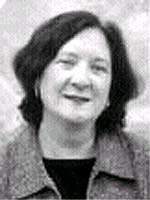
Jacqueline Levine received the American Jewish Committee Award for Distinguished Jewish American and Israeli Feminists in January 2000 at a ceremony in the Israeli Knesset. (17) Jacqueline Levine is affiliated with the Jewish Fund for Justice.
"The Jewish Fund for Justice (JFJ) was founded in 1984. … The Jewish Fund for Justice is a national, publicly supported foundation that acts on the historic commitment of the Jewish people to tzedakah (righteous giving) and tikkun olam (repair of the world). We believe that a commitment to combating poverty in the U.S. and the injustices underlying it is an essential part of our core identity and values as Jews.
"JFJ observes Shabbat and Jewish holidays. JFJ serves kosher, dairy or vegetarian meals at our public functions." (30)
How does this mission statement relate to Talmud laws enabling a man to get rid of his wife without financial settlement if she has physical defects? Such physical defects may include bad breath, moles, a harsh voice, breasts that are too far apart, a scar from a dog bite, excessive perspiration. Hunchbacks, the lame, the blind and a woman injured in her sexual organs may also be divorced without financial settlement.
MISHNAH. … [If a woman was betrothed] on condition that she has no bodily defects, and she was found to have such defects, her betrothal is invalid. If he married her without making any conditions and she was found to have bodily defects, she may be divorced without a kethubah. All defects which disqualify priests disqualify women also. — Kethuboth 72b, Kethuboth 75a et seq.
Surely sincere Jewish social reformers need to confront issues like these.
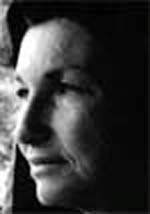
Esther Broner co-founded Seder Sisters in 1976. The Seder Sisters designed a Passover ceremony that mimics the traditional ceremony, substituting words, events, and names chosen to highlight "women's issues."
"She is a pioneer Jewish feminist. Her novels, such as A Weave of Women re-examines the Biblical matriarchs and their place in Scripture. She also discusses creating new religious ceremonies to highlight life cycle events central to women's lives and to include women's experiences in Jewish ritual. In the mid-70's E. M. Broner spent time with her family in Israel. In her book, The Telling, she describes the beginning of the women's seder idea: 'But this would be different. The invited men would prepare the meal … The women would contemplate the traditional Haggadah and write new and relevant prayers.'" — (39)
But how do the Seder Sisters feel about the Talmud traditions concerning the sexual use of women in marriage? Despite a woman's objections, she must put up with anal intercourse. As one rabbi said, "My daughter! the Torah hath permitted thee to him — what then can I do for thee?"
Even more definitive of anal intercourse and a wife's body generally, the Talmud teaches:
… a man may do whatever he pleases with his wife [at intercourse]: A parable; Meat which comes from the abattoir, may be eaten salted, roasted, cooked or seethed; so with fish from the fishmonger … A woman once came before Rab and complained. 'Rabbi! I set a table before my husband, but he overturned it.' Rab replied; Wherein does it differ from a fish? — Nedarim 20b
See also Really, Really Kosher Sex.
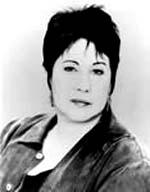
Phyllis Chesler co-founded Seder Sisters in 1976. The Seder Sisters designed a Passover ceremony that mimics the traditional ceremony, substituting words, events, and names chosen to highlight "women's issues."
In 1972, Chesler's book Women and Madness was published. The 25th anniversary edition asked these questions:
"Why are so many women in therapy, on psychiatric medication, or in mental hospitals? Who decides these women are mad? Why do therapists have the power to deem a woman mentally ill when she asserts herself sexually, economically, or intellectually? Why are women pathologized, but not treated, when they exhibit a normal human response to abuse and stress - including the lifelong stress of second-class citizenship?
"Phyllis Chesler confronts questions like these and persuasively argues that double standards of mental health and illness exist and that women are often punitively labeled as a function of gender, race, class, or sexual preference. Based on in-depth interviews with patients and an analysis of women's roles in myths and history, Women and Madness is an incomparable work." (32)
When Chesler was lamenting the second-class citizenship of women, it is a pity she was not more curious about her own culture. Instead of studying the defining documents on the treatment of Jewish women, Chesler became a board Member of the International Committee of the Women of the Wall (a group that aims to gender-equalize the ceremonies at the Wailing Wall in Jerusalem). Chesler writes:
"On December 1, 1988, I was one of 70 Jewish women from Europe, North America, Australia, Asia, South America, and the Middle East who prayed together in Jerusalem, out loud, with a Torah, wearing ritual garments, for the first time in thousands of years, at the Kotel, better known as the Western, or "Wailing," Wall. The Kotel is arguably the spot most sacred or symbolic of all that was lost and longed for in Jewish history: King Solomon's Temple, our, own country, an army to protect Jews from being beaten, raped, slaughtered in Christian and Islamic countries." — (33)
"In March 1989, when the attacks continued during subsequent prayer services, the newly organized Women of the Wall (WOW) petitioned the Israeli Supreme Court for an order to allow women to pray together at the wall, with a Torah and wearing ritual garments, and to protect them from violence. According to Bonna Haberman, visiting scholar at Brandeis, 'women shouted, cursed, and pushed at us. [On two occasions] men burst into the women's section … circled, began to tear at us. [Men] hurled metal chairs at us. The police [watching nearby) refused to intervene. On a third occasion, a black wall of men cursing and taunting us blocked our entry … (Men) violently thrashed at the petition. One wild black-coated fellow burst through, hurling a chair at our heads. One woman collapsed under the blow, bleeding from the neck and head and requiring hospital treatment.'" — (33)
But where are the Jewish feminists who are willing to confront the teachings of the Talmud vis á vis their own stated ideals?

Elizabeth Holtzman received the American Jewish Committee Award for Distinguished Jewish American and Israeli Feminists in January 2000 at a ceremony in the Israeli Knesset. (17)
As a former US Congressman and New York lawyer, Holtzman undoubtedly understands the basic American principles of law, justice and liberty. Is Holtzman familiar with the Talmud law that requires a rapist to marry his victim? The result of that law, of course, is that the rape victim must marry her rapist. As a former Member of Congress and Presidential appointee, (27) why doesn't Holtzman use her position to warn America about some of the pitfalls in Talmud justice? Does she not know, or does she just not care?

The late Bella Abzug received the American Jewish Committee Award for Distinguished Jewish American and Israeli Feminists in January 2000 at a ceremony in the Israeli Knesset. (17)
When her father died Bella was only 12. Although the custom of saying Kaddish is traditionally reserved for sons, she stood by herself in synagogue each day for a year to say the mourning prayer. "In retrospect, I describe that as one of the early blows for the liberation of Jewish women. But in fact, no one could have stopped me from performing the duty traditionally reserved for a son, from honoring the man who had taught me to love peace, who had educated me in Jewish values." (25)
But how educated was Abzug in "Jewish values"? According to the law of the Talmud, a father can sell his daughter or otherwise give her away in marriage while she is still a minor. At no time did Abzug ever bring the suppression of women under Talmud law to the attention of the public. Did she not know?
We loved ye, Bella …
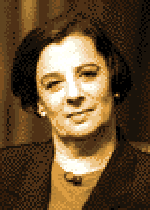
Blu Greenberg received the American Jewish Committee Award for Distinguished Jewish American and Israeli Feminists in January 2000 at a ceremony in the Israeli Knesset. (17)
Blu is the wife of Rabbi Irving Greenberg, the Holocaust defender. Mrs. Greenberg has written two books, How to Run a Traditional Jewish Household and On Women and Judaism. According to Talmud law, her husband has the right to sell their daughter into slavery, but she does not have that right. (Sotah 23a)
Greenberg is often described as an "Orthodox Jewish feminist." Given the above regulation, is this not a form of discrimination against women? Mrs. Greenberg has never made this one of her issues.

You can help in the battle for Truth, Justice, and the American Way! Fight the forces of censorship and suppression of the Talmud, and bring about understanding between peoples of different faiths.
Download this site to your desktop computer.
Make CDs and distribute them to friends, neighbors, ministers, and community leaders.
Email your favorite essay to your email list.
Post your favorite essay to discussion forums.
Print your favorite essays and give them to those not on the Internet.
Flyers advertising Come-and-Hear.com can be distributed throughout your community.
 Genuine Come and Hear™ CDs do not contain executable programs. When making CDs, do not include any files that end in .exe, .com, .bat, .vbs, .doc, .pif, .sit, or .scr. The person receiving the CD should use his own browser to view the files. This helps to protect him from harmful programs and viruses.
Genuine Come and Hear™ CDs do not contain executable programs. When making CDs, do not include any files that end in .exe, .com, .bat, .vbs, .doc, .pif, .sit, or .scr. The person receiving the CD should use his own browser to view the files. This helps to protect him from harmful programs and viruses.
It is astonishing to note the amount of hostile misrepresentation
that exists in regard to woman's position in Jewish life.
"The relation of the wife to the husband was,
to all intents and purposes, that of a slave to her master,"
are the words of a writer in the Encyclopedia of Religion and Ethics.
That this judgment is radically false
may be proved from hundreds of instances throughout Scripture.
— Rabbi Dr. J.H. Hertz (1)
MISHNAH. … A man may sell his daughter,
but a woman may not sell her daughter.
— Babylonian Talmud, Tractate Sotah 23a
Soncino 1961 Edition, page 115
Talmud scholars generally present the Talmud laws concerning women and family issues in a favorable light. (41) For example, see the Nashim Foreword, written by the Very Reverend the Chief Rabbi of the British Commonwealth the late Dr. J.H. Hertz, (3) and the Nashim Introduction, written by Jews College scholar and Soncino Talmud editor, Rabbi Dr. Isidore Epstein. (4)
In America, the Talmud is presented both as the Word of God and as an exemplar of practical law that has been tested and applied over millennia. Our Supreme Court and our law schools are integrating Talmud law into our society. (See America Is Rapidly Becoming Talmudized).
Without intending any disrespect for the opinions of rabbinical experts who extol the virtues of the Talmud, we prefer to take a pragmatic approach. We prefer to look at Talmud law ourselves. We have already learned much by doing exactly that.
What We Have Learned Thus Far
In Sex with Children by Talmud Rules, (34) we learned that under Talmud law, grown men may have sexual intercourse with children. Sex with girls younger than three years old is specifically permitted. We learned that the little girls are wounded and bleed as a result. Little girls may bleed after each copulation. The Sages teach that the repeated bleeding is the result of the hymen growing back and being newly ruptured with each copulation. We learned that Jewish law permits male homosexuality if the passive partner is younger than nine years old, and that homosexuality between adult men is punishable by death. We wondered how these laws could be integrated into the present system of American law and custom.
In Talmud Laws of Menstruation, (35) we learned that the Talmud's menstruation laws "concern the very being of the soul of the Jew." These laws decree that for a period of approximately two weeks, women are "unclean" and contaminate everyone and everything they touch; husbands may not have sexual intercourse with their wives. To guard against a husband and wife accidentally having intercourse during her period, a virtuous Jewish wife inserts rags into her vagina to test for menstrual fluids before and after intercourse. Having intercourse during menstruation is an actionable criminal offense under Talmud law. We wondered how laws would comport with privacy sensitivities of contemporary American culture.
In Jewish Harems in Talmud Law, (36) we learned that there is some question about how many wives a Jew is permitted. The rabbis argue — 4 wives, 12 wives? 24? 48? We learn that the relationship between wives can be bitter, and that causes concern. We also learned that there is a movement among today's Orthodox Jews to reinstate open polygamy.
In Really, Really, Kosher Sex (37) we learned the Talmud Sages' tips for eroticism. The wife must submit to any sexual demand the husband makes, including anal intercourse, even if she hates it. Lovemaking must take place in the dark, lest the husband see his wife and find something repulsive. No talking during intercourse, no looking at "that place," no kissing "that place," etc. But unfortunately, we didn't learn what "that place" is.
Do Your Own Research
Now, in a two-part essay, "Talmud Daughters Become Talmud Wives" (this page) and the next, And So a Talmud Marriage Ends, we will examine other laws of the Talmud that affect women. But first a word of warning. These essays do not pretend to be a comprehensive overview of Talmud marriage and divorce laws. Rather, we hope they serve as an entry point for further research and discussion.
Women are discussed throughout the Talmud, but especially in tractates Sanhedrin, Niddah, Kethuboth, Yebamoth, Gittin, and Sotah. We have cited excerpts from most of these in the following article. But don't rely upon our interpretation. We have placed the entire tractates on line so you can see the excerpts in context.
Do your own research on women's issues with the Come and Hear™ Search Engine. The following search terms may yield results: virgin, harlot, girl, damsel, whore, menstruant, woman, wife, adultery, sister, daughter, lewdness, bogereth, sotah, adulteress, marital, cohabitation, intercourse, cohabit, matrimonial, rival.
What's Coming Up?
In the following articles, we will discover that, under Jewish law:
- A father owns everything his daughter finds and earns
- A father is urged to marry his daughter off before puberty
- A father can sell his minor daughter into marriage, concubinage, or slavery
- A rape victim must marry the rapist
- After marriage, the husband owns everything the wife finds and earns
- The only way a married woman can acquire wealth is through inheritance or gift
- A husband has exclusive use of his wife's inheritance while she is alive, though it remains hers
- A husband can divorce his wife at any time on payment of a settlement (kethubah)
- A kethubah can be nullified for failure to perform wifely duties properly
- A kethubah can be nullified if the wife has physical imperfections, anything from a hunched back to bad breath or moles
- A wife dismissed without kethubah faces destitution; hence the threat of divorce gives a husband almost absolute authority over his wife
- A wife cannot divorce her husband
- If a wife runs away, she has no property to take with her. She is a pauper
- If she goes with another man without a divorce, she and the other man are stoned
- On rare occasions a Beth din (court) may force a husband to give his wife a divorce
We will have a look at these doctrines in more detail. In the following excerpts, we sometimes omit footnotes. Please follow the link to the Come and Hear™ hypertext to read those footnotes. Now, let's get some legalities out of the way.
(Note: When excerpting quotations from the Talmud, we sometimes omit non-germane text and footnotes. Omission of text is indicated by an ellipsis (…). To see the full text and footnotes, follow the hot link at the end of the excerpt. It is our pleasure to make available on line a number of Talmud tractates, so that you can see the excerpt in full context. We indicate unprintable Hebrew characters, words, and phrases with the symbol [H].)
Some Important Legal Definitions
The authority of a father over his daughter depends (according to one definition) upon her sexual maturity. When a girl is fully developed sexually, she is a bogereth, and no longer a minor. Therefore the Sages concern themselves with the intimate details of a pubescent girl's physical development. Phenomena of significance include: A wrinkle beneath the breast, breasts hanging down, breasts beginning to shake, a dark ring appearing around the nipple, the nipple sinking and rising again when a hand is placed on it, the mons veneris growing lower, and the appearance of at least two pubic hairs.
Note that the one categorical indicator of fecundity, menstruation, is not mentioned as an indicator of sexual maturity.
MISHNAH. THE SAGES SPOKE OF [THE PHYSICAL DEVELOPMENT OF] A WOMAN IN FIGURATIVE SPEECH: AN UNRIPE FIG, A FIG IN ITS EARLY RIPENING STAGE AND A RIPE FIG. SHE IS LIKE AN UNRIPE FIG' WHILE SHE IS YET A CHILD; A FIG IN ITS EARLY RIPENING STAGE' WHEN SHE IS IN THE AGE OF HER MAIDENHOOD. DURING BOTH THE LATTER AND THE FORMER AGES, THEY RULED, HER FATHER IS ENTITLED TO ANYTHING SHE FINDS AND TO HER HANDIWORK AND TO THE RIGHT OF INVALIDATING HER VOWS. 'A RIPE FIG' — AS SOON AS SHE BECOMES A BOGERETH, AND HER FATHER HAS NO LONGER ANY RIGHT OVER HER.
WHAT ARE THE MARKS [OF A BOGERETH]? R. JOSE THE GALILEAN SAYS: THE APPEARANCE OF THE WRINKLE BENEATH THE BREAST. R. AKIBA SAYS: THE HANGING DOWN OF THE BREASTS. BEN AZZAI SAYS: THE DARKENING OF THE RING AROUND THE NIPPLE. R. JOSE SAYS: [THE DEVELOPMENT OF THE BREAST TO A STAGE] WHEN ONE'S HAND BEING PUT ON THE NIPPLE IT SINKS AND ONLY SLOWLY RISES AGAIN.
— Babylonian Talmud, Tractate Niddah 47a
Soncino 1961 Edition, page 327
Commentary on this passage continues in the Gemara. Note the word bagruth, which appears in the same context as bogereth and appears to have the same meaning.
GEMARA. … Our Rabbis taught: What are the marks of bagruth? R. Eleazar son of R. Zadok stated, When the breasts begin to shake. R. Johanan b. Beroka stated, When the top of the nose (17) grows white. But is not a woman when this grows white already old? — Rather said R. Ashi, when the top of the nose splits. (1) R. Jose stated, When a ring is formed around the nipple. R. Simeon stated, When the mons veneris grows lower.
— Babylonian Talmud, Tractate Niddah 47a
Soncino 1961 Edition, pages 328-329
Reverend Dr. Israel Slotki, translator of Tractate Niddah, amplifies the text with footnotes:
- The central circle of the oblate part of the breast (Jast.),
- Aliter (Jast.). When the skin of the central circle of the oblate part of the breast appears wrinkled.
— Rev. Dr. Slotki
Here is an alternate definition of bogereth from the Soncino Talmud Glossary:
Bogereth. A girl from the age of twelve and a half years plus one day onwards.
Here are some other pertinent definitions from the Glossary:
Na'arah. A girl between the ages of twelve years and one day and twelve and a half years plus one day.
There were two stages of marriage: betrothal (or the promise of matrimony) and home-taking:
Erusin. (Lit., 'betrothal') — a formal betrothal, which cannot be annulled without a bill of divorce
Nissu'in. The ceremony of home-taking, which completes the marriage
Another important term is Get
Get. A deed or legal document; when used without further specification denotes generally a writ of divorce.
Let us also review the meaning of usufruct, because we will see it used in the upcoming discussions.
Usufruct. In the civil law, the right of enjoying a thing, the property of which is vested in another, and to draw from the same all the profit, utility, and advantage which it may produce, provided it be without altering the substance of the thing. — Black's Law Dictionary, 5th Edition
Now let's look at the Talmud teachings more closely.
Intellectual Orientation Toward Women
Rabbi Dr. H. Freedman introduces us to Chapter I of Tractate Kiddushin. He states that the theme of this chapter is acquisition, including acquisition of slaves, real estate, movables, Sanctuary property — and wives.
CHAPTER I commences by stating how a woman is acquired in marriage. The unit of thought, or the connecting link, however, is not marriage but acquisition, and the Tractate immediately proceeds to discuss the modes of acquisition employed elsewhere, viz., for Hebrew and heathen slaves, real estate, movables, and how the Sanctuary acquires property.
— Rabbi Dr. H. Freedman (8)
The word kinyan is frequently used to denote the execution of a contract of betrothal. For example, the word is so used in Kethuboth 102b. A sum of money is given by the groom to the father, and Reverend Dr. Israel W. Slotki writes of that in a footnote:
- Sc. the sum of money or object of value which the man gives to the woman as a token of betrothal which constitutes the required kinyan.
— Rev. Dr. Israel W. Slotki (14)
The word kinyan itself is defined in the Soncino Talmud Glossary as:
Kinyan. 'Acquisition'; the legal acquisition of either landed or movable property.
Daughters May Be Sold
MISHNAH. … A MAN MAY SELL HIS DAUGHTER, (5) BUT A WOMAN MAY NOT SELL HER DAUGHTER. A MAN MAY GIVE HIS DAUGHTER IN BETROTHAL (6) BUT A WOMAN MAY NOT GIVE HER DAUGHTER IN BETROTHAL.
— Babylonian Talmud, Tractate Sotah 23a
Soncino 1961 Edition, page 115
Reverend Dr. Abraham Cohen, translator of Tractate Sotah, amplifies the text with a footnote:
- As a bondwoman (Ex. XXI, 7).
- Without her consent when she is a minor.
— Rev. Dr. Cohen
Reverend Dr. Cohen mentions a bondwoman, that is, a slave. Slavery is described in part in Exodus 21. Male slaves are free after seven years of service, but Exodus 21:7 tells us that female slaves are not set free.
- If thou buy an Hebrew servant, six years he shall serve: and in the seventh he shall go out free for nothing.
…- And if a man sell his daughter to be a maidservant, she shall not go out as the menservants do.
— Exodus 21:2, 7 (KJV)
Thus, by citing Exodus 21:7, Reverend Dr. Cohen confirms that under Talmud law, a father may sell his daughter into a lifetime of slavery.
By ancient Hebrew tradition, a slave is owned completely. Sara gave her slave Hagar to Abraham for begetting the children that Sarah thought she could not have. There is no mention that Hagar consented to the arrangement, or that she had a choice. After the child was born, Abraham sent Hagar into the wilderness to die (Genesis 21:14). It was all perfectly legal.
But let us return to other aspects of a young girl's life under the Talmud.
Betrothed by Intercourse
A father may betroth his minor daughter by allowing the groom to have intercourse with her, or by accepting money or other valuables in exchange for her.
MISHNAH. A FATHER HAS AUTHORITY OVER HIS DAUGHTER (1) IN RESPECT OF HER BETROTHAL [WHETHER IT WAS EFFECTED] BY MONEY, (2) DEED (3) OR INTERCOURSE; (4)
— Babylonian Talmud, Tractate Kethuboth 46b
Soncino 1961 Edition, pages 265-266
Reverend Dr. Israel Slotki, translator of the above section of the Soncino Kethuboth, amplifies the above text with footnotes:
- While she is under the age of twelve and a half years and one day.
- Sc. the money belongs to him.
- The receipt of the deed by him effects his daughter's betrothal.
- It is within his rights to allow such an act to have the validity of a kinyan (v. Glos.).
— Rev. Dr. Slotki
Father or Husband Owns Her Labor
While a daughter is under her father's authority, the father owns anything she finds and all her handiwork. Once she is married, the husband owns anything she finds and all her handiwork. Her husband is obliged to support her, ransom her, and pay for her funeral.
MISHNAH. … HE IS ENTITLED TO ANYTHING SHE FINDS AND TO HER HANDIWORK; [HE HAS THE RIGHT] OF ANNULLING HER VOWS (5) AND HE RECEIVES HER BILL OF DIVORCE; (6) BUT HE HAS NO USUFRUCT (7) DURING HER LIFETIME. (8) WHEN SHE MARRIES, THE HUSBAND SURPASSES HIM [IN HIS RIGHTS] IN THAT HE HAS (9) USUFRUCT DURING HER LIFETIME, (10) BUT HE IS ALSO UNDER THE OBLIGATION OF MAINTAINING AND RANSOMING HER (11) AND TO PROVIDE FOR HER BURIAL. R. JUDAH RULED: EVEN THE POOREST MAN IN ISRAEL MUST PROVIDE (12) NO LESS THAN TWO FLUTES AND ONE LAMENTING WOMAN.
— Babylonian Talmud, Tractate Kethuboth 46b
Soncino 1961 Edition, page 266
- V. Num. XXX. 4ff.
- If she was divorced during her betrothal before attaining her adolescence (v. Glos. s.v. bogereth).
- Of property that came into her possession from her mother's side.
- Such property passes into the possession of a father as heir to his daughter only after her death.
- In addition to the privileges enjoyed by a father.
- Cf. infra 65b, Kid. 3b.
- If she was taken captive.
- For his wife's funeral.
— Rev. Dr. Slotki
Not Ownerless Property
In Tractate Yebamoth 107a, you will find this statement by the Talmud school, Beth Shammai:
MISHNAH. … THE DAUGHTERS OF ISRAEL ARE NOT OWNERLESS PROPERTY.
— Babylonian Talmud, Tractate Yebamoth 107a
Soncino 1961 Edition, page 738
A minor girl belongs to the father "always" until the moment she enters under the authority of her husband. (All but one footnote in the following passage have been omitted; they are available through the hot link.)
MISHNAH. SHE REMAINS (8) UNDER THE AUTHORITY OF HER FATHER UNTIL SHE ENTERS UNDER THE AUTHORITY OF HER HUSBAND [BY GOING INTO THE BRIDAL CHAMBER] AT MARRIAGE. IF HER FATHER DELIVERED HER TO THE AGENTS OF THE HUSBAND SHE PASSES UNDER THE AUTHORITY OF HER HUSBAND. IF HER FATHER WENT WITH HER HUSBAND'S AGENTS OR IF THE FATHER'S AGENTS WENT WITH THE HUSBAND'S AGENTS SHE REMAINS UNDER THE AUTHORITY OF HER FATHER. IF HER FATHER'S AGENTS DELIVERED HER TO HER HUSBAND'S AGENTS SHE PASSES UNDER THE AUTHORITY OF HER HUSBAND.
— Babylonian Talmud, Tractate Kethuboth 48a-48b
Soncino 1961 Edition, page 276
Look at footnote 8, written by the translator Reverend Dr. Israel W. Slotki. The [H] represents a Hebrew character.
- [H], lit., 'for ever', 'always'.
— Rev. Dr. Slotki
In Reverend Dr. Slotki's opinion, the correct Hebrew translation indicates that a Jewish woman never passes into her own authority while living with her father. She is under her father "for ever" — or until she is passed to her husband. From that point onward, she is under the authority of her husband.
Reverend Dr. Slotki's understanding is consistent with that of Rabbi Dr. H. Freedman, translator of the Tractate Sanhedrin. Rabbi Dr. Freedman commented on the wickedness of the father of a bogereth who "keeps her unmarried, that he may profit by her labour whilst endangering her chastity." (12) If a bogereth were able to keep the products of her own labor, Rabbi Dr. Freedman's statement would have no meaning.
Status of a Young Girl
Now let's summarize what we have learned. A father has authority over his young daughter; he can betroth her to whom he chooses, and her consent is not required. He can betroth her by selling her for money or property, or allowing her prospective husband to have sexual intercourse with her.
While living with her father, her father owns anything the girl finds, and anything she produces; but her father may not use the property given to her by her mother.
After she has married, her husband owns anything she finds, and anything she produces; her husband may use the property given to her by her mother's will; i.e., the married woman cannot accumulate wealth by any means except by inheritance, and cannot use any of her inherited wealth independent of her husband.
Contracts Enforceable by Death
A betrothal is legally binding, and cannot be dissolved without a Get (divorce order). A betrothed girl is legally obliged to be faithful to her prospective husband. If she has sexual intercourse with another man and is caught, she will be stoned to death or strangled, depending upon her age at the time of the offense.
GEMARA. … Shila taught: There are three modes [of execution] in the case of a [betrothed] damsel [who played the harlot]. If witnesses appeared against her in the house of her father-in-law [testifying] that she had played the harlot in her father's house she is stoned at the door of her father's house, as if to say, 'See the plant that you have reared'. If witnesses came [to testify] against her in her father's house that she played the harlot in his house she is stoned at the entrance of the gate of the city. If having committed the offence she eventually attained adolescence she is condemned to strangulation.
— Babylonian Talmud, Tractate Niddah 44b-45a
Soncino 1961 Edition, page 254
Some Hope for Fatherless Girl
If the girl's father is dead and her mother or brother marry her off to a man she does not want, there is hope. If she did not give her consent, she can walk away from her husband without any formal procedures; if she did give her consent (though a minor) she must make a declaration before a Beth din (court).
MI'UN. Lit., 'refusal'); a declaration by a fatherless girl who has been married off by her mother or brothers under age, that she does not wish to live with her husband. Such a declaration made by her in the presence of a Beth din secures her freedom without the requirement of a Get.
MISHNAH. WHICH MINOR MUST MAKE THE DECLARATION OF REFUSAL? (1) ANY WHOSE MOTHER OR BROTHERS HAVE GIVEN HER IN MARRIAGE WITH HER CONSENT. IF, HOWEVER, THEY GAVE HER IN MARRIAGE WITHOUT HER CONSENT SHE NEED NOT MAKE ANY DECLARATION OF REFUSAL. (2)
— Babylonian Talmud, Tractate Yebamoth 107b
Soncino 1961 Edition, page 746
Reverend Dr. Israel W. Slotki, translator of the above section of the Soncino Kethuboth, amplifies the text with footnotes:
- If she desires to leave her husband.
- She may leave her husband without any legal formality, and may marry any other man.
— Rev. Dr. Slotki
Marriage to Ants and Cabbage Heads
The Sages of the Talmud believe that, for a woman, any husband is better than none. Unhappiness and misery in marriage are preferable to a happy and prosperous life in solitude. Here is the view of the Sages:
GEMARA. … A woman is satisfied with any sort [of husband] as Resh Lakish said. For Resh Lakish stated: 'It is preferable to live in grief (13) than to dwell in widowhood'. (14) Abaye said: With a husband [of the size of an] ant her seat is placed among the great. (15) R. Papa said: Though her husband be a carder (16) she calls him to the threshold and sits down [at his side]. (1) R. Ashi said: Even if her husband is only a cabbage-head (2) she requires no lentils (3) for her pot. (4).
— Babylonian Talmud, Tractate Kethuboth 75a
Soncino 1961 Edition, pages 469, 470
Reverend Dr. Israel W. Slotki, Talmud scholar and translator of this section of the Tractate Kethuboth, amplifies the text with footnotes:
- Or 'together', 'as husband and wife'. V. following note.
- Yeb. 118b. This is a woman's maxim. She prefers a married life of unhappiness and misery to a happy and prosperous life in solitude. [H] (adv.) 'with a load of grief', 'in trouble' (Jast.) Aliter: (Cf. supra n. 13) 'two bodies' (Rashi); 'two persons' (Levy).
- A woman's opinion of a married life (v. Yeb. l.c.).[H] pl. of [H], 'a free woman'.
- [H], 'flax-beater' (Rashi), a watchman of vegetables' (Aruch.), i.e., of a poor and humble occupation.
- To shew her friends that she is a married woman. She is proud to be in the company of a husband however humble his occupation and social status.
- [H], i.e., 'dull', 'ugly' (v. Jast.): 'of a tainted family' (Rashi).
- I.e., even a cheap vegetable.
- A woman is content to dispense even with the cheapest enjoyments for the sake of a married life.
— Rev. Dr. Slotki
So according to the Sages, being married to an "ant" or a "cabbage head" is preferable to being unmarried.
Either Wives or Whores
A father is under great societal pressure to marry off his daughter early. If there is a delay and she is not married at about the age of 12 1/2, she is in danger of becoming a whore. It is best to marry the girl off before puberty. Respectable spinsterhood is not an option; the word "spinster" does not appear in the 1952 General Index published as part of the 1961 Edition of the Soncino Talmud.
GEMARA. As it has been taught: Do not profane thy daughter to cause her to be a whore; R. Eliezer said: This refers to marrying one's [young] daughter to an old man. R. Akiba said: This refers to the delay in marrying off a daughter who is already a bogereth. (1)
R. Kahana said on R. Akiba's authority: The only poor in Israel is the subtly wicked and he who delays in marrying off his daughter, a bogereth. (2) But is not one who thus delays himself subtly wicked? (3) — Abaye answered: [76b] This is its meaning: Which poor man is subtly wicked? He who delays marrying off his daughter, a bogereth. (4)
… He who loves his wife as himself and honours her more than himself, (8) and leads his children in the right path, and marries them just before they attain puberty — of him Scripture saith, And thou shalt know that thy tabernacle shall be in peace and thou shalt visit thy habitation, and shalt not sin. (9)
— Babylonian Talmud, Tractate Sanhedrin 76a-76b
Soncino 1961 Edition, page 517
Rabbi Dr. H. Freedman, translator of this section of the Soncino Sanhedrin, amplifies the above text with footnotes:
- Having attained puberty, she may become unchaste if not married. Marriage, of course, was then at a far earlier age than now.
- This is explained further on.
- Why 'and he who delays etc.': the two are identical. His wickedness consists in that he keeps her unmarried, that he may profit by her labour whilst endangering her chastity.
- Through his poverty he delays her marriage, that he may profit from her labour, The poor man has no other opportunity of cunning wickedness
…- By providing her with fine ornaments (Rashi).
- Job. V. 24. This proves that it is meritorious to marry off one's children whilst minors.
— Rabbi Dr. Freedman
What dutiful father would hesitate to marry off his daughter when she is a minor, given that delay may cause her to become a whore? Given that girls can be betrothed and married off at the age of three, it would seem that many daughters were married off before they could make an informed decision.
Punishment for Rape — Who Is Punished?
This Mishnah deals with the consequences of rape to the rapist, and of seduction to the seducer.
MISHNAH. … WHAT [IS THE DIFFERENCE] BETWEEN [THE PENALTIES OF] A SEDUCER AND THOSE OF A VIOLATOR? THE VIOLATOR PAYS COMPENSATION FOR THE PAIN BUT THE SEDUCER DOES NOT PAY COMPENSATION FOR THE PAIN. THE VIOLATOR PAYS (8) FORTHWITH (9) BUT THE SEDUCER [PAYS ONLY] IF HE DISMISSES (10) HER. THE VIOLATOR MUST DRINK OUT OF HIS POT (11) BUT THE SEDUCER MAY DISMISS [THE GIRL] IF HE WISHES. WHAT IS MEANT BY (12) 'MUST DRINK OUT OF HIS POT'? — EVEN IF SHE IS LAME, EVEN IF SHE IS BLIND AND EVEN IF SHE IS AFFLICTED WITH BOILS [HE MAY NOT DISMISS HER]. IF, HOWEVER, SHE WAS FOUND TO HAVE COMMITTED AN IMMORAL ACT OR WAS UNFIT TO MARRY AN ISRAELITE HE MAY NOT CONTINUE TO LIVE WITH HER, FOR IT IS SAID IN SCRIPTURE, AND UNTO HIM SHE SHALL BE FOR A WIFE, [IMPLYING] A WIFE THAT IS FIT 'UNTO HIM.
— Babylonian Talmud, Tractate Kethuboth 39a
Soncino 1961 Edition, pages 218-219
Several aspects of this Mishnah deserve closer study. What is the "pot" from which the rapist must drink? It is an earthen vessel such as is used as a receptacle for refuse; this is the Sages' metaphor for the rape victim. Note also that the entire penalty for the pain the rapist has caused the girl is paid to the girl's father (see Soncino Footnote 8, below).
Reverend Dr. Israel W. Slotki, Talmud scholar and translator of this section of the Tractate Kethuboth, explains this in footnotes:
- To the damsel's father.
- Even if he marries her.
- This is explained infra.
- [H], an earthen vessel used as a receptacle for refuse or as a plant pot; i.e., the violator must marry his victim whatever her merits or defects.
- Lit., 'how'.
— Rev. Dr. Slotki
Note that the Mishna does not provide for the wishes of the rape victim to be consulted. The presumption is that she'll do as she's told and marry the man who committed the brutal act upon her. If, however, it can be shown she ever committed an "immoral" act, the rapist is excused on that account. In the discussion that follows, Abaye introduces an amendment, stating that the rape victim and her father may refuse the marriage, but Raba disagrees. See the Gemara of Tractate Kethuboth 39a-b for the full discussion.
The doctrine expressed in the Mishna is derived directly from Deuteronomy 22:28-29:
- If a man find a damsel that is a virgin, which is not betrothed, and lay hold on her, and lie with her, and they be found;
- Then the man that lay with her shall give unto the damsel's father fifty shekels of silver, and she shall be his wife; because he hath humbled her, he may not put her away all his days.
This is the wording in the King James Version. The New International Version is less delicate: "If a man happens to meet a virgin who is not pledged to be married and rapes her …"
Rape As a Crime Against Property
Compare this treatment of the rapist with the treatment of a man who seduces a betrothed maiden.
MISHNAH. THE FOLLOWING ARE STONED: … HE WHO COMMITS ADULTERY WITH A BETROTHED MAIDEN.
— Babylonian Talmud, Tractate Sanhedrin 53a
Soncino 1961 Edition, page 359
If the rape victim is not married or promised in marriage, the rapist marries the woman. However, if she is married or promised in marriage, the rapist is stoned to death. Thus we see the object of the law is not so much to punish the rapist as to protect the property rights of other male Jews.
Indeed, the lesson one might draw this law is — if you see a beautiful girl who is not married or betrothed, rape her and she's yours. Courtship is an expensive and unnecessary luxury.
Talmud Popularizers vs. the Talmud
Repeated over and over in the Talmud are doctrines from the Sages themselves. Young girls — from younger than three years of age through pre-puberty and up to bogereth state — can be sold or otherwise given in marriage. (See Sex with Children by Talmud Rules for specific information on three year olds.) Their consent is not required. Nor, or course, would the consent of a minor be legally meaningful.
Talmud spokespersons seem to have a hard time dealing with this. When writing of women's issues, they usually avoid mentioning these laws, or mischaracterize them. Surely this is not advisable. If these Talmud spokespersons believe that the Talmud is the word of God, they should speak up in clear voices and state their beliefs. We can listen respectfully, and decide whether Talmud policies strike the same chord in our hearts. If they do, we can adopt them. But we should be allowed to make a fully informed decision.
— Rabbi Shmuley Boteach
Rabbi Shmuley Boteach is the author of more than a dozen books popularizing Judaism. Titles include Judaism for Everyone, Dating Secrets of the Ten Commandments, Kosher Sex, Kosher Emotions, The Jewish Guide to Adultery, Why Can't I Fall in Love.
Rabbi Boteach obviously feels a little awkward about the Talmud laws on marriage and rape. First defining Torah, Rabbi Boteach says of these laws:
"Torah" refers to all 24 books of the 'written law' plus the 'oral code' as written and compiled by the ancient rabbis in the Mishnah and the Talmud.
…
The Torah also made marrying a woman against her will illegal and imposed extremely harsh penalties on rape.
— Rabbi Boteach (28)
Rabbi Boteach seriously mischaracterizes the Talmud teaching on marriage and rape, as we have just seen.
— Rabbi Adin Steinsaltz
Rabbi Adin Steinsaltz, famed Israeli Talmud scholar and recipient of the Israel Award, Israel's top civilian honor, is the author of The Essential Talmud, a 269-page compendium written for popular consumption. Rabbi Steinsaltz is currently translating the Talmud into French, Russian, and English. While you almost certainly will not find a complete and uncensored copy of the Talmud (with a workable and comprehensive subject index [18]) in your local public library, you may find Rabbi Steinsaltz's The Essential Talmud.
Here is what Rabbi Steinsaltz says:
… although a father may marry off his daughter and cancel her vows, his authority is limited to minor daughters who have not yet reached the age of sexual maturity (twelve). Neither a father nor any other individual may impose his will on an adult daughter or attempt to force her into a marriage against her will.
— Rabbi Steinsaltz (15)
A key word in this statement is "adult." Before the girl is adult, she certainly may be married or sold without her consent. Recall the great pressures on Jewish fathers to marry off their minor daughters. Neither we nor Rabbi Steinsaltz could know what percentage of Jewish women were married off as minors; but to fail to mention the fate of minor girls and the societal pressure on fathers to marry off their daughters as minors — while at the same time lauding the independence of bogereths — is disclosing less than the full truth. We suspect that many, if not most, brides were married before reaching puberty.
— Rev. Dr. Abraham Cohen
Rev. Dr. Abraham Cohen translated the tractates Sotah and Abodah Zarah into English for Jews College/Soncino Press. You will find his signature and the bottom of the Introductions to each of these tractates. He also wrote a popularized compendium, Everyman's Talmud, that is still in print and may be available at your local public library.
Now let's compare the work of Rev. Dr. Cohen, the popularizer, with Rev. Dr. Cohen, the Talmud scholar and translator. Rev. Dr. Cohen (the translator) rendered (Sotah 23a (see above) as follows: "A man may sell his daughter, [5] but a woman may not sell her daughter. A man may give his daughter in betrothal [6] but a woman may not give her daughter in betrothal." (16) Footnotes written by Rev. Dr. Cohen read: "[5] As a bondwoman (Ex. XXI, 7). [6] Without her consent when she is a minor."
Remember that Rev. Dr. Cohen, Talmud scholar and translator, must have been familiar with the many other Talmud doctrines governing marriages of minor children — even children younger than three. With this in mind, let's see what Rev. Dr. Cohen, the popularizer, writes concerning a girl's consent in marriage:
According to Talmudic law, 'a man is forbidden to give his daughter in marriage while she is a minor, until she is grown up and says, I wish to marry so-and-so (Kid. 41a). If he married her while in her minority she could repudiate the marriage on reaching the age of twelve, and have it annulled without a divorce.
— Rev. Dr. Cohen (11)
This statement from Rev. Dr. Cohen (the popularizer) is untrue. Only a fatherless girl can escape an unwanted marriage (Yebamoth 107b, quoted above). To support his untrue statement, Rev. Dr. Cohen quotes from Chapter II of Tractate Kiddushin 41a. The Soncino Tractate Kiddushin was translated by Rabbi Dr. H. Freedman, who describes Chapter II in his Introduction:
CHAPTER II returns to betrothal, with which the whole is exclusively concerned. It treats of betrothal by proxy; more detailed laws on money or its equivalent as one of the modes of betrothing a woman; conditional betrothal; and the simultaneous betrothal of more than one woman.
— Rabbi Dr. H. Freedman (7)
So we see the subject of Chapter II is specifically the arrangement of marriage through proxies. It begins with these words:
MISHNAH. A MAN CAN BETROTH [A WOMAN] THROUGH HIMSELF OR THROUGH HIS AGENT. A WOMAN MAY BE BETROTHED THROUGH HERSELF OR THROUGH HER AGENT. A MAN MAY GIVE HIS DAUGHTER IN BETROTHAL WHEN A NA'ARAH [EITHER] HIMSELF OR THROUGH HIS AGENT.
— Babylonian Talmud, Tractate Kiddushin 41a
Soncino 1961 Edition, page 204
The Gemara of Kiddushin 41a contains the phrase that Rev. Dr. Cohen quotes out of context:
GEMARA. … A MAN MAY GIVE HIS DAUGHTER IN BETROTHAL WHEN A NA'ARAH. Only when a na'arah, but not when a minor: this supports Rab. For Rab. Judah said in Rab's name. One may not give his daughter in betrothal when a minor, [but must wait] until she grows up and says, 'I want So-and-so.'
— Babylonian Talmud, Tractate Kiddushin 41a
Soncino 1961 Edition, page 205
Rev. Dr. Cohen gives his readers the impression Kiddushin 41a represents the Talmud legal doctrine on minor girls and betrothal, without mentioning the specific context of the provision (proxy marriage). He fails to mention the many doctrines on minor girls and betrothal that fall outside Kiddushin 41a.
What are we to think? We must recognize that Rev. Dr. Cohen was under editorial supervision when he translated Tractate Sotah of the Soncino Talmud. He was part of the Jews College team under editor Rabbi Dr. Isidore Epstein. The reputation of Dr. Epstein's school, Jews College of London, was on the line. Many learned rabbis and Hebrew scholars would read the Jews College-Soncino translation. Rev. Dr. Cohen's Everyman's Talmud, however, was intended not as a book for learned Jews, but as a popularization for the uninformed public. Rev. Dr. Cohen had no fear of challenge from the readers of Everyman's Talmud, and he presents the Talmud doctrines that cause less offense. We believe Rev. Dr. Cohen failed to meet the Rudin Standard for openness and full disclosure. (19)
This website is dedicated to realizing the goal close to the heart of the Very Reverend the Chief Rabbi of the United Hebrew Congregations of the British Commonwealth, Professor Jonathan Sachs. It is his hope that people of different religious faiths can come to understand each others' beliefs. How can this happen when spokespersons do not give accurate representations of those beliefs?
Protection of the Kethubah
The Old Testament permits a man to dismiss his wife at will:
- When a man hath taken a wife, and married her, and it come to pass that she find no favour in his eyes, because he hath found some uncleanness in her: then let him write her a bill of divorcement, and give it in her hand, and send her out of his house.
Much to the credit of the Sages of the Talmud, they sought to soften this harshness by instituting the kethubah (plural, kethuboth). Here is the definition from the Soncino Talmud Glossary:
KETHUBAH. (Lit., 'a written [document]'); (a) a wife's marriage settlement which she is entitled to recover on her being divorced or on the death of her husband. The minimum settlement for a virgin is two hundred zuz, and for a widow remarrying one hundred zuz; (b) the marriage contract specifying the mutual obligations between husband and wife and containing the amount of the endowment and any other special financial obligations assumed by the husband.
Rabbi Dr. Epstein tells us:
The kethubah — the deed of marriage settlement instituted primarily with the object of protecting a wife against hasty divorce, had to be drawn up and duly completed before the consummation of marriage. In view of the right vested by the Bible in the husband to divorce the wife at his pleasure — a theoretical right which the Rabbis could not entirely set aside - it was felt that no woman could enter upon matrimony with a free and easy mind without being in possession of this safeguard to her marital security. The Sages accordingly forbade marital relations as long as the kethubah had not been completed. Furthermore, they declared that it was forbidden for husband and wife to live together for a single moment without a kethubah (B.K. 89a); and where the kethubah was lost, they had to abstain from intercourse until another kethubah had been made out.
— Rabbi Dr. Epstein (5)
Obviously, the possibility of a wife being dismissed at a moment's notice looms large in the Sages' minds, for Rabbi Dr. Epstein states: "… and where the kethubah was lost, they had to abstain from intercourse until another kethubah had been made out." No sex until the financial arrangements have been set in stone.
What Price Virginity? One Hundred Zuz
The wife's virginity on her wedding night affects the amount of the kethubah. Therefore, virginity, literally, has a price. Rev. Dr. Israel W. Slotki states this in his Introduction to the Tractate Kethuboth:
The minimum amounts of the kethubah to which virgins, widows, divorcees or other women belonging to the various strata of social and religious life are entitled, and the conditions governing the forfeiture of her kethubah by a wife in the absence of her virginity, are duly indicated …
— Rev. Dr. Slotki (9)
In the following, "zuz" and "maneh" are units of currency. A maneh is one hundred zuz. Footnotes have been omitted from this excerpt, but may be viewed by following the link at the end of the cite.
MISHNAH. A MAIDEN — HER KETHUBAH IS TWO HUNDRED [ZUZ], AND A WIDOW — A MANEH. A MAIDEN, WHO IS A WIDOW, [OR] DIVORCED, OR A HALUZAH FROM BETROTHAL — HER KETHUBAH IS TWO HUNDRED [ZUZ], AND THERE LIES AGAINST THEM THE CHARGE OF NON-VIRGINITY.
— Babylonian Talmud, Tractate Kethuboth 10b
Soncino 1961 Edition, page 52
The Universal Jewish Encyclopedia published in 1942 states that the price specified for a virgin was equivalent to about $30 (1942 US dollars). (10) We thus see that a virgin's base kethubah is worth twice as much as a non-virgin's.
See Tractate Kethuboth 6b for the function of the groomsmen, including page 23, footnotes 12 and 13 (Kethuboth 6b, footnotes 37 and 38 in Come and Hear™ hypertext). (40)
Rabbis Have Virginity Tests
When the bride does not bleed on the wedding night, the groom might consult a rabbi. The Talmud Sages have several tests for virginity. A conversation between the bride, the groom, and the rabbi contains a description of one test:
GEMARA. … 'My master, I have had intercourse [with my newly-wedded wife] and I have not found any blood.' She [the wife] said to him, 'My master, I was a virgin.' He said to them: Bring me that cloth. (1) They brought him the cloth, and he soaked it in water and he washed it and he found on it a good many drops of blood. (2) [Thereupon] he [Rabban Gamaliel] said to him [the husband]: Go, be happy with thy bargain.'
— Babylonian Talmud, Tractate Kethuboth 10a
Soncino 1961 Edition, page 50
Rabbi Dr. Samuel Daiches amplifies the text with the following footnotes, which appear as footnotes 45 and 46 in the Come and Hear™ hypertext version:
- Upon which they spent the night.
- The blood was covered by semen.
— Rabbi Dr. Daiches
Here is an account of the "cask of wine" test. If a non-virgin sits over an open cask of wine, the perfume of the wine passes through her body. The wine and can be smelled on her breath by a rabbi. On the other hand, if a virgin sits over an open cast of wine, the perfume of the wine does not pass through her body, and, naturally, a rabbi cannot smell it. Here is an account of the conversation between the bride, the groom, and the rabbi that describes the technique.
GEMARA. … 'My master, I have had intercourse [with my newly-wedded wife] and I have not found any blood.' She [the wife] said to him, 'My master, I am still a virgin.' He [then] said to them: Bring me two handmaids, one [who is] a virgin and one who had intercourse with a man. They brought to him [two such handmaids], and he placed them upon a cask of wine. [In the case of] the one who was no more a virgin its smell (1) went through,(2) [in the case of] the virgin the smell did not go through.(3) He [then] placed this one [the young wife] also [on a cask of wine], and its smell (4) did not go through. He (5) [then] said to him:(6) Go, be happy with thy bargain.(7)
— Babylonian Talmud, Tractate Kethuboth 10b
Soncino 1961 Edition, pages 50-51
Rabbi Dr. Samuel Daiches amplifies the text with the following footnotes:
- I.e., the smell of the wine.
- One could smell the wine from the mouth (Rashi).
- One could not smell the wine from the mouth.
- I.e., the smell of the wine.
- Rabban Gamaliel.
- To the husband.
- The test showed that the wife was a virgin.
— Rabbi Dr. Daiches
These tests give us an insight into the mindset of husbands, wives, and rabbis in the Talmud days. Modern American men and women might be uncomfortable with the concept behind these tests.
Contraception
Under the Talmud, none. Not in any form, not for anybody. See Really, Really Kosher Sex (Contraception) for details.
Double Standards
The Talmud Sages do not value male virginity. Theirs is a culture of double standards. Do a search on "virgin" to see how many times "virgin" refers to a man. For a man, visiting a harlot and paying for her services was perfectly acceptable — even among rabbinical students. (See Really, Really Kosher Sex.)
Many bygone cultures and legal systems had sexual double standards, of course, in which women were treated very much like cows sold in a market place. We don't necessarily single out the Sages for blame. However, the Talmudic system is different from others; it forms the bedrock of the Judaic system that is being offered for future America.
America Is Rapidly Becoming Talmudized
In 1991, the US Congress declared the Talmudic Noahide Laws to be the basis "upon which our great Nation was founded" (see America's New Government Church). Under Noahide Law regulations, idolaters (which includes Christians by definition) are put to death.
In 1999, the Supreme Court agreed to consider an amicus brief based wholly on Talmudic law (see Sentence and Execution).
In November 2002, the American Orthodox Jewish community held a kosher dinner in the Supreme Court building to celebrate the establishment of the National Institute for Judaic Law. (6) The dinner was attended by 200 people, including three Supreme Court Justices. The purpose of the Institute is to introduce Talmudic laws into the US legal system and law schools.
It is thus the clear civic duty of every American to become intimately acquainted with the Talmud. Read articles at:
America's New Government Church: http://www.come-and-hear.com/editor/america_1.html
Death Penalty: http://www.come-and-hear.com/editor/capunish_1.html
Kosher Dinner: http://www.come-and-hear.com/editor/cp-jp-11-09-2002 and http://www.come-and-hear.com/editor/cp-jw-01-08-03
It therefore behooves us to examine Talmud laws concerning marriage and divorce very carefully and ask: Is this the direction in which we want to go?
We've seen how wives are acquired. Now let us look at how to get rid of a wife no longer wanted.
Thank you for your consideration of the above,
Carol A. Valentine, Ear@Come-and-Hear.com
July 14, 2003 ( This article is on line at http://www.come-and-hear.com/editor/america_6.html )
|
Navigate Carol Valentine's America Under the Talmud — Will It Work for US? | |||||
 Howdy! |
 The Roadmap |
 Censorship |
 Death Penalty |
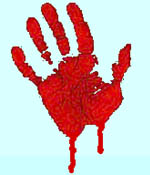 Blood Ritual |
 New America |
| Navigate This Site | |
 | |
| Home | |
| Valentine | |
| Dilling | |
| Talmud | |
| The Rabbis | |
| Supplement | |
| Glossary | |
| Download | |
| Admin | |
Endnotes:
- This and other Come and Hear™ Studies on Talmudic Judaism can be found online:
- http://www.come-and-hear.com/editor
- The Jewish Religion: Its Influence Today by Elizabeth Dilling, complete with all 300 exhibits, can be found online:
- http://www.come-and-hear.com/dilling
- Soncino Babylonian Talmud tractates, with Forewords, Introductions, Glossary, List of Abbreviations, and footnotes. Now you can study the Babylonian Talmud in full context and with the running commentary of the finest scholars of Judaism:
- Tractate Berakoth: http://www.come-and-hear.com/berakoth
- Tractate Shabbath: http://www.come-and-hear.com/shabbath
- Tractate Yebamoth: http://www.come-and-hear.com/yebamoth
- Tractate Kethuboth: http://www.come-and-hear.com/kethuboth
- Tractate Nedarim: http://www.come-and-hear.com/nedarim
- Tractate Nazir: http://www.come-and-hear.com/nazir
- Tractate Sotah: http://www.come-and-hear.com/sotah
- Tractate Gittin: http://www.come-and-hear.com/gittin
- Tractate Baba Kamma: http://www.come-and-hear.com/babakamma
- Tractate Baba Mezi'a: http://www.come-and-hear.com/babamezia
- Tractate Baba Bathra: http://www.come-and-hear.com/bababathra
- Tractate Sanhedrin: http://www.come-and-hear.com/sanhedrin
- Tractate Abodah Zarah: http://www.come-and-hear.com/zarah
- Tractate Horayoth: http://www.come-and-hear.com/horayoth
- Tractate Niddah: http://www.come-and-hear.com/niddah
- Tractate Tohoroth: http://www.come-and-hear.com/tohoroth
- Search the Talmud http://www.come-and-hear.com/tindex.html
- Download all the above resources for local study, CD, or mirror web site:
- http://www.come-and-hear.com/download
